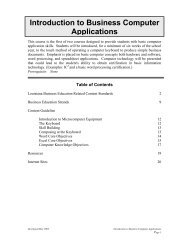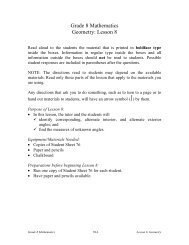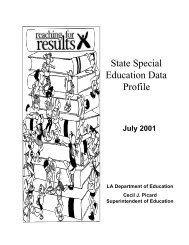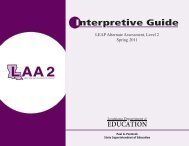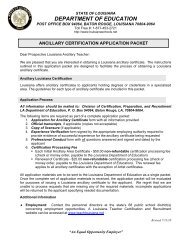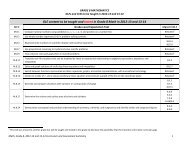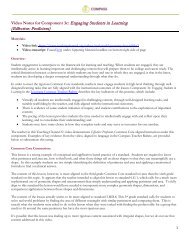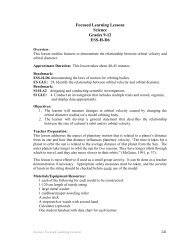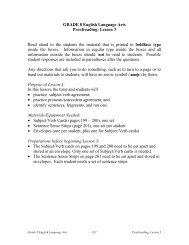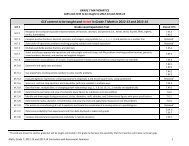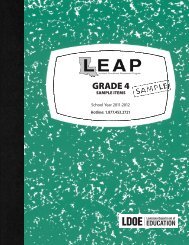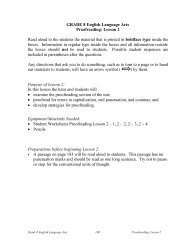School Improvement - Louisiana Department of Education
School Improvement - Louisiana Department of Education
School Improvement - Louisiana Department of Education
You also want an ePaper? Increase the reach of your titles
YUMPU automatically turns print PDFs into web optimized ePapers that Google loves.
• For the findings to be considered educationally or practically significant, the effect on student<br />
achievement should be large enough to be <strong>of</strong> practical value. For example, gains on the standardized test<br />
should be 10 percentile points to be considered educationally significant (American Institutes for<br />
Research, 1999).<br />
A study may have a significant result in that the achievement gains reported in the study are very clearly the result<br />
<strong>of</strong> the reform practices. However, the actual gains in achievement may be modest in size; when this is the case,<br />
the study may be said to have limited practical significance. In this context, school community members need to<br />
decide if the cost <strong>of</strong> implementing the practice or strategy is outweighed by the size <strong>of</strong> the student gains that can<br />
be achieved.<br />
Putting scientifically based research in the school reform context:<br />
The Comprehensive <strong>School</strong> Reform Program usually begins with school staff gathering and analyzing data about<br />
their school. Once this process is completed, they identify and prioritize their needs, establish goals, and then<br />
begin to research strategies and methods that will help them achieve those goals. The following step‐by‐step<br />
process illustrates the place that scientifically based research occupies in the context <strong>of</strong> school reform.<br />
Step One:<br />
Step Two:<br />
Step Three:<br />
Step Four:<br />
Step Five:<br />
<strong>School</strong>s collect data that give a complete, accurate picture <strong>of</strong> the current state <strong>of</strong><br />
the school.<br />
<strong>School</strong> community analyzes data to determine and prioritize needs.<br />
After prioritizing needs, schools write goal statements to address prioritized needs.<br />
<strong>School</strong>s develop potential strategies to achieve stated goals.<br />
<strong>School</strong>s begin topical literature review, identifying research base <strong>of</strong> potential<br />
strategies. (See sources <strong>of</strong> research abstracts.)<br />
Step Six:<br />
Step Seven:<br />
<strong>School</strong>s use abstracts to determine if the research addresses (1) the theoretical<br />
basis <strong>of</strong> a program or practice, and/or (2) issues <strong>of</strong> implementation, replicability,<br />
and relevance, or (3) evidence <strong>of</strong> the effects <strong>of</strong> that strategy or practice on student<br />
achievement. Not all research addresses all three topics, but more than one may<br />
be addressed in an individual research study.<br />
If an examination <strong>of</strong> the abstract indicates a study is relevant to the identified<br />
needs <strong>of</strong> the school, the study should be examined in more detail. <strong>School</strong>s can use<br />
the Standards for Identifying Effective Approaches to make a determination about<br />
the practice or strategy <strong>of</strong> interest. Guidelines for Judging the Quality <strong>of</strong> a Study<br />
and Understanding Significance will provide additional help.<br />
Step Eight:<br />
<strong>School</strong>s determine if the examined research is <strong>of</strong> high quality, replicable, and<br />
relevant. The examined research might meet the criteria <strong>of</strong> scientifically‐ based<br />
research, the “strong evidence” criteria, or be at some other point along the<br />
spectrum <strong>of</strong> “evidence based.” In some cases there will be no, or little, high quality<br />
evidence that this practice, strategy or set <strong>of</strong> strategies will increase positive<br />
outcomes for students.<br />
Adapted from: Office <strong>of</strong> Elementary and Secondary <strong>Education</strong>, U.S. <strong>Department</strong> <strong>of</strong> <strong>Education</strong>, Comprehensive <strong>School</strong> Reform Program<br />
Office, August 2002.<br />
140



